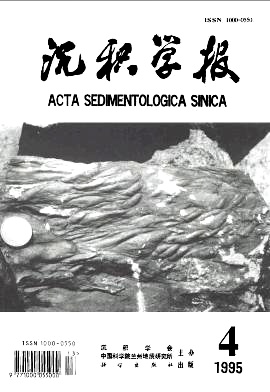Gao Zhenzhong, Luo Shunshe, He Youbin, Zhang Jisenand, Tang Zijjun. The Middle Ordovician Contourite on the West Margin of Ordos[J]. Acta Sedimentologica Sinica, 1995, 13(4): 16-26.
| Citation:
|
Gao Zhenzhong, Luo Shunshe, He Youbin, Zhang Jisenand, Tang Zijjun. The Middle Ordovician Contourite on the West Margin of Ordos[J]. Acta Sedimentologica Sinica, 1995, 13(4): 16-26.
|
The Middle Ordovician Contourite on the West Margin of Ordos
-
1 Department of Geology, Jianghan Petroleum Institute, Hubei 434102;
-
2 The Exploration and Development Institute of Changqing Petroleum Exploration Bureau, Gansu 745101
- Received Date: 1994-01-12
- Publish Date:
1995-12-10
-
Abstract
The Middle Ordovician on the west margin of Ordos is represented by a succession of deep-water sediments in which contourites are well developed. According to grain-size and component, the contourites can be classified into: ①calcarenitic contourite, ②calcisiltitic contourite, ③calcilutitic contourite and ④ bioclastic contourite. Calcarenitic contourite is mainly composed of sparite calcarenite and is characterized by coarser grain, very irregular boundary plane, development of parallel stratification and ripple bedding. The laminae in ripple bedding imply a palaeocurrent direction of northwest, which is coincident with the strike of the regional palaeoslopes. Calcisiltitic contourite consists mainly of micrite calcisiltite and is always interbedded with calcilutitic contourite or present both below and above calcarenitic contourite. Parallel stratification or small-scale ripple bedding are common in calcisiltitic contourite and the laminae imply a palaeocurrent direction of northwest. On the whole, calcilutitic contourite comprises (muddy) micritic limestone, which commonly contains a variable proportion of calcisiltite and bioclastic materials and is a common occurence of bioturbational structures. Sometimes, some horizontal stratifications can be found in this contourite. Bioclastic contourite almost consists of a succession of echinederm fragment limestone with a thickness of 2m~5m and the thickest is near to 7m, which is composed of a series of single beds with a thickness of 20cm ~ 50cm where large-scale cross-stratifications are well developed, whose laminae imply a direction of northwest. The first three types are well developed in Guanzhuang, Pingliang, Gansu Province, and the fourth type is mainly found in the Zhuozishan mountain, Inner Mongolia.In the study area, some sequences of contourite are complete and similiar to the typical sequence of Gonthier (1984), and some sequences are incomplete and others are special, i. e.,only consisting of calcarenitic contourite. Ripples, cross stratification and texture have generally revealed a strong northward palaeoflow direction along the palaeoslope on the west margin of Ordos. The distribution of all kinds of contourites in the section confirms the existence of the Pingliang contourite drift.
-
References
|
[1]
|
1.段太忠、郭建华、高振中、李增华、曾允孚,1990,华南古大陆边缘湘北九溪下奥陶统碳酸盐等深岩丘,地质学报,(2):131-143。
2.Bein, A. and Weiler. Y.,1976. The Cretaceous Talme Yafe Formation; a contour current shaped sedimentary prismof calcareous detritus at the continental margin of the Arabian Craton, Sedimentology, 23 (4):511-523.
3.Faugeres, J. C.,Mererais, M. L. and Stow, D. A. V.,1993. Contourite drift types and their distribution in theNorth and South Atlantic (kean basins, Sedimentary Geology. 82, 189-206.
4.Faugeres, J. C. and Stow. D. A. V.,1993, Bottom-current-controlled sedimentation; a synthesis of the contouriteproblem. Sedimentary Geology. 82. 287-297.
5.Gonthier, E. G.,Faugeres, J. C. and Stow, D. A. V.,1984, Contourite facies of the Faro Drift. Gulf of Cadiz.In stow, D. A. V. and Piper, D. J. W. (ed.),Fine-Grained Sediments: Deep-Water Processes and Facies, BlackwellScientific Publications.,275-292.
6.Heezen, B. C. and Hollister, C. D.,1964, Deep-sea current evidence from abyssal sediments: Marine Geology. 1,141-174.
7.Heezen, B. C.,Hollister. C. D. and Ruddiman, W. F.,1966, Shaping of the continental rise by deep geostrophic contour currents, Science. 152. 502-508.
8.Hollister, C. D.,1993, The concept of deep-sea contourites, Sedimentary Geology, 82. 5-14.
9.Nelson, C. H.,Baraza, J. and Maldonado. A.,1993. Mediterranean undercurrent sandy contourites, Gulf of Cadiz.Spain. Sedimentary Geology. 82, 103-132.
10.Stow, D. A. V.,1979, Distinguishing between fine-grained turbidites and contourites on the Nova Scotian deep water margin, Sedimentology. 26, 371-387. |
-
-
Proportional views

-






 DownLoad:
DownLoad: